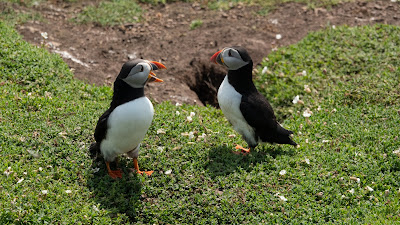The shuttle boat to Skomer Island.
A grey seal resting on a zodiac.
A puffin surveying the view from his burrow.
The carpet of bluebells.
The beautiful coastline.
Cliffs jam packed with nesting seabirds.
The comical puffin.
A razorbill.
A razorbill and two penguin like guillemots.
John got this great shot.
The sunset from our campground.
Wednesday, May 17th.
We awoke to another lovely blue-sky morning, perfect and rare apparently, for our journey for the day. John had booked a trip for us via a little shuttle to Skomer Island just off the coast, which is a wildlife and nature preserve owned by the National Trust. It is home to colonies of seabirds, including guillemots, razorbills, manx shearwaters, several different types of gulls and crows, and puffins. The comical looking puffins are the attraction for most people. When we arrived at the landing site, we had to climb a series of stairs right past nesting razorbills and puffins. We were amazingly close and the birds were not bothered, just curious maybe. We were given rules for our visit which included not straying from or stepping off the path as both shearwaters and puffins nest in burrows in the ground and the island is covered in these holes. A misplaced foot could collapse the roof. There are 120,000 pairs (about half of the world’s population) of manx shearwaters on the island, but we didn’t see them as they only come to their borrows in the cover of darkness. The only ones we did see were the carcasses of the ones unlucky enough to be caught by the great black backed gulls. Apparently, the noise of their nocturnal return is loud and chaotic. To witness it a few people can book overnight stays in an old repurposed farm building. We walked around the whole island in a counterclockwise direction, as directed, to minimize the number of people we’d pass thus avoiding the possibility of errant steps off the path. We had a great day walking from 11am to 4 and photographing the birds. I’ve often seen islands of colonies nesting birds and always wanted to visit one. I’ve seen some in the Galapagos and colonies of penguins, but this was different. The birds all have their places, the gulls mostly nest on the ground or high on the cliffs. The razorbills and guillemots in layers on the ledges of the cliffs and the puffins and shearwaters on burrows underground. An amazing community that is able to exist and raise their young mainly in safety as there are no land-based predators or rats. There are only two mammals, a unique mouse-like vole and rabbits. The predators are airborne, a few owls, three or four pairs of peregrine falcons and the large black backed gulls. We returned from the island at 4 before going into the ‘town’ of Marloe for dinner at the misnamed Lobster Pot Inn as they don’t serve it. The town only has about 40 inhabitants and most of the other houses are now rented out as b’b’s or vacation homes. The only other business, a café, had a sign outside saying they were now permanently closed. We had a sorry meal and a beer before going back to our tent for the night.
















No comments:
Post a Comment